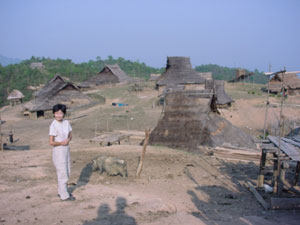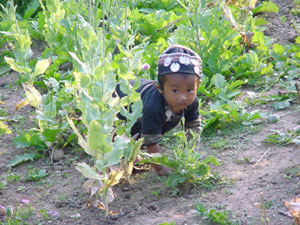![]()
| Laos | Phongsali | 2002.02.28 - 03.05 |
Hill Tribe Trek
The highlight of Laos is a trek through the jungle to primitive hill tribe villages. The most popular treks originate in Luang Nam Tha and Muang Sing. These cities have trekking guide associations, brochures, and high prices. The northernmost province of Phongsali, on the other hand, has fewer tourists, less infrastructure, and maybe a more authentic experience. For these reasons, we chose Phongsali as our trekking base.
HILL TRIBE TREK
Phongsali is a remote town with 4 hours of electricity per day from
18:00 to 22:00 and running water in the morning every other day.
In Phongsali, Masami asked several guesthouse owners where we could
find an English speaking trekking guide. The uniform response was,
"I don't know." Wes chose to nap after the grueling 10-hour
truck ride up dusty winding mountain roads from Udomxai to
Phongsali. Horizontal and half asleep, a knock sounded at the door.
An English speaking trekking guide was making his rounds at the
guesthouses looking for business. In Laos, it rarely pays to
look for information. If the service exists, it will find you.
We departed the next morning at 06:00 with our guide Thong Chang. His English was comprehensible thanks to several years of monastic training in Vientiane. The walk was hot, long, and hard through humid jungle covering steep terrain. Exhausted and soaked in sweat, we trudged up and down farming trails, waded through a river, and eventually reached Per Yinxang Mai village 10 hours later.
Our overnight in Per Yinxang Mai felt like the most remote habitation on earth. A flashlight was their most advanced piece of equipment. Buildings were bamboo. The only water source was a stagnant pool 200 meters downhill. Half the children and all women wore traditional indigo cloth decorated with old coins and metal beads. The other children and men wore ragged Western shirts and trousers. Men ceased wearing traditional dress 2 generations ago. Villagers grew their own vegetables alongside opium poppies in enclosed garden plots protected from livestock trample. Aside from medical care and new batteries, the village appeared to be self sufficient. We slept in the village teacher's hut.
The teacher charged us 20,000 Kip (US$2.10) per person for lodging, dinner, and breakfast. Dinner was simple rice, greens, and chicken. The palate bored before the stomach filled. Breakfast was more of the same, minus the chicken. 6 hours walk took us to the Nam Ou riverside town of Vattai where a family housed us. Our room and board fee was the same, but food tasted better, seasoned with garlic.
Day 3 was simple boat and truck transport to Phongsali. The one-hour boat took us to Hat Xai, the closest dirt road. From there, a truck loaded with sand accepted passengers to ride atop for one hour to Phongsali. Remarkably, after 2 days of walking through the jungle, Phongsali seemed like an inviting return to civilization, even without water and electricity.
The overall bodily hardships from our trek were limited to electrolyte depletion, flea bites, some tick bites, and a leach sucking blood from Masami's ankle. The experience was good, but like much of Laos, the effort to get there outweighed the returns.
GETTING THERE
From Luang Prabang, a 6-hour bus ride goes to Udomxai where lack of
connection to Phongsali forces an overnight. The next morning, a
10-hour truck ride over bumpy, dusty, winding road goes to Phongsali.
Before completion of the truck ride, all passengers have sore
butts, backs, and necks, and are completely covered in road dust.
 |
Masami observes Per Yinxang Mai village life. 27 bamboo structures house 160 residents, most of whom are children. The elected 33-year old village chief is responsible for conflict resolution and overall well-being of the community. |
 |
Per Yinxang Mai women travel beyond the village to collect firewood, go to market, and gather edible vegetation. All dress in a one-piece length of indigo colored cloth that covers much of the body but often leaves the breasts exposed. |
 |
An infant crawls through an opium producing poppy field while his mother collects garden vegetables for supper. |
Copyright © 2000-2002 Wes and Masami Heiser. All rights reserved.